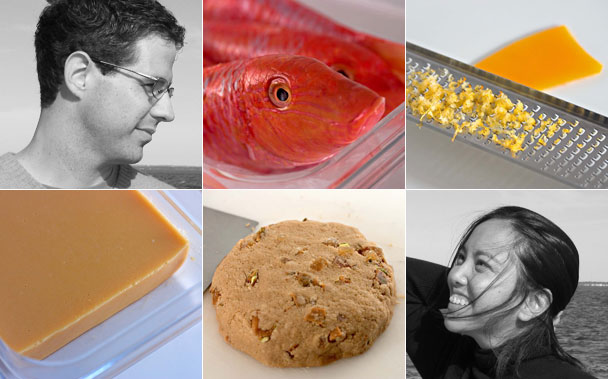For the past four years, the chefs Alex Talbot and Aki Kamozawa have catalogued their kitchen experiments—which often involve chemicals unfamiliar to most home cooks—on their blog, Ideas in Food. Providing full recipes and detailed yet engaging descriptions of the thought processes behind each dish, the blog has developed a following among chefs and amateur food lovers alike.
Talbot and Kamozawa, a husband-and-wife team, started out in the kitchen at Restaurant Clio in Boston; after working for four years as co-executive chefs at the Keyah Grande resort in Colorado, they moved to New York City, where they now teach cooking classes and cater private events. Gourmet’s Christy Harrison spoke to Talbot about the blog, the allure of hydrocolloids, and the frustrations of cooking for a New York audience.
Q. So how did you guys decide to start Ideas in Food?
A. We got started when we were out in Colorado, and a friend of ours who was the general manager of Keyah Grande had his own blog. We didn't really know what the heck a blog was. That was a quieter time, and we were out in the middle of nowhere. We talked about it and figured [a blog] was a good way to catalog our information, so we signed up with Typepad. We just started writing. And we didn't really know where we were going with it or what it was going to do; if you look back at the archives, you can see the culinary evolution, the voice that develops as we got comfortable with things.
Originally we had planned on having one person writing in italics and one person writing in a regular font, but that just seemed silly. Our voices became apparent, for the most part—you can tell something written by me from something written by Aki, especially if you read the website on a regular basis.
Q. It's sort of rare in food blogs to have two people collaborating like this.
A. Certainly. And I guess that's what's really exciting. We've cooked together for years now, and we've always been co-chefs.
Q. Did you meet in culinary school?
A. We actually met in Boston, at Clio, where we worked together. So we don't know anything else, besides working with each other. And what's great is that we both have different approaches to food, so at day's end it gets filtered by both of us. We are editors for each other, and we can really grow and get better because of that.
Q. When you first started out, were you doing a lot of writing about the chemicals and technologies that you work with now?
A. I think that kind of developed over time. We started out just working with ingredients, but ingredients like hydrocolloids are looked at as something different—something strange and odd that needs to be defined, as opposed to just being another ingredient. And that's where we were as chefs—how do you integrate something new into a cuisine? Or rather how do you integrate something old, because it's been around for years, it just has a bad name.
Q. Well, it's been industrialized—it’s been a part of industry and not a part of home cooking.
A. Right. To put it simply—and we talk about this in our class on hydrocolloids—as chefs and cooks, our job is to source great ingredients and to highlight them. The hydrocolloids used in the industrial sense were designed to make it so that you could start off with a poor ingredient and try to extend its shelf life and change its texture. If you start off with something like that—if you start off with shit, basically—and you try to extend its shelf life, you've just got extended junk. But if we start off with an impeccable ingredient—a beautiful pumpkin, or a lovely apple, or a roasted beet—and then we use these ingredients to highlight its flavor or accent its texture or improve upon it, then we're just elevating the food.
Take a parsley puree, for example. If you puree parsley and strain it, you basically just have parsley water. So to thicken it, you’re going to have to add something: olive oil, butter. And those ingredients have flavors that don’t taste like parsley. They taste delicious, but they don’t taste like parsley. So what if you could add an ingredient that would give you the structure and mouthfeel that you’re looking for, without taking away flavor?



 Pinterest
Pinterest


